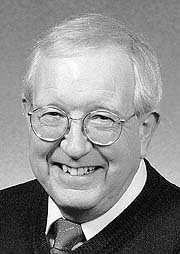|
March 10, 2003
UCSC astronomer John Faulkner to address U.K.
astronomy meeting
By Tim Stephens
The Royal Astronomical Society (RAS) has invited John
Faulkner, professor
of astronomy and astrophysics, to give the Roger Tayler
Memorial Lecture
at the National Astronomy Meeting next month in Dublin.
|

|
| John Faulkner |
Faulkner's talk, which will take place on April 10, will be the last
in a series of five annual lectures established by the RAS to honor
Tayler after his death in 1997.
Tayler was a highly distinguished physicist and astronomer who did
pioneering work in several areas of research. He served the RAS for
many years, first as secretary, then as treasurer, and finally as president.
He was also the managing editor of the society's major journal for 20
years.
Faulkner worked with Tayler at Cambridge University when
Faulkner was
a graduate student of Fred Hoyle, another giant in the
field of astronomy.
At the time, Hoyle had so many graduate students working
with him that
he decided he needed another senior researcher to help
guide them, Faulkner
said.
"[Hoyle] brought Tayler back to Cambridge to help mentor this
large group of graduate students, and he was very good at that,"
Faulkner said. "He was really a delightful guy and he did some
very important work in those early days. Later he became a much loved
president of the Royal Astronomical Society. So I really felt honored
to receive the invitation to give the final lecture in this
series."
The National Astronomy Meeting at which Faulkner will give
the lecture
brings together all of the major astronomy organizations of
the United
Kingdom and the Irish Republic. The title of Faulkner's
lecture is "Standing
on the Shoulders of Dwarfs," a sly twist on one of
Isaac Newton's
most famous remarks that Faulkner has used to describe his
work on the
structure and evolution of stars.
Stellar evolution is an area in which both Tayler and Faulkner made
significant contributions, and it continues to be the primary focus
of Faulkner's research. In 1966, Faulkner published a landmark paper
explaining a key phase in the life of stars like the Sun, which are
known to astronomers as red dwarfs. His most recent work
not only explains
another key phase of stellar evolution (the "red
giant" phase),
but also provides a unifying viewpoint that links all three
major stages
in the evolution of stars like the Sun.
The Sun is currently in the first of these major stages,
the "main
sequence" phase, which accounts for about 90 percent of the life
of a star. When a main sequence star starts to exhaust the hydrogen
fuel in its core, the core begins to condense while the
outer portions
of the star expand. It then becomes an extremely large
"red giant,"
with a very dense core and a large outer envelope.
Eventually, the core becomes hot enough to burn helium and the star
enters the "horizontal branch" phase, the third major stage
in its evolution. Finally, most of the outer portions of the star are
blown off and it becomes a "white dwarf."
Faulkner's 1966 paper explored computationally the strange structure
of stars in the horizontal branch phase, with their double
energy source
of helium and hydrogen. His new work explains analytically why stars
become red giants, and also sheds new light on the other
two main stages
in the evolution of stars like the Sun.
"Not only does the red giant build on the previous
red dwarf stage,
but what is developing in the interior of the red giant is
like a white
dwarf, the obvious precursor of the bare white dwarf it
will ultimately
become," Faulkner said.
The Sun is about half way through the main sequence phase
of its evolution.
It will remain essentially unchanged for another 5 billion years or
so before it swells up to become a red giant 150 to 200
times its current
size.
"A red giant is like a white dwarf with a storage problem. And,
as many of us might consider doing when faced with this problem, it
remodels the attic. That's why and how it gets that
big," Faulkner
said.
Return to
Front Page
|